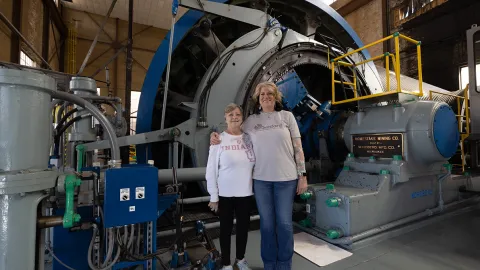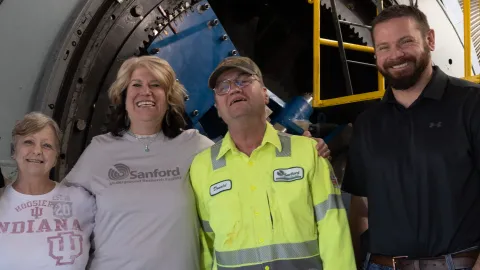Three Ross Hoist operators retire with 85 years of combined experience
Three hoist operators, who worked at both Homestake and SURF, David Bauer, Donald Daywitt, and Laurie Adkins-Heydon have retired.
The hoists at the Sanford Underground Research Facility (SURF) that convey personnel, equipment, and components between the surface and the underground are essential for operations. SURF hoist operators, who control these 90-year-old machines, are key members of the team that keep them running.
This spring and summer, three hoist operators who have 85 years of combined experience, retired from SURF. They are among a group of personnel who worked for both the former Homestake Mine before 2001 and SURF.
“The combined experience of these hoist operators, totaling more than eight decades, goes a long way here, especially with these big pieces of machinery and the responsibility these hoist operators have,” said Colton Clark, the hoists and maintenance superintendent at SURF. “They have other people on the end of the rope, it's a very safety sensitive job.”
Laurie Adkins-Heydon started at Homestake as a hoist operator in 1991 and worked there until the mine closed a decade later. She was a single mother at the time, and the job was life changing.
“I was so grateful to have the work. To get on with a job that had benefits, and a 401k back then was a wonderful thing. Then I’m grateful to have worked there as long as I did. I’m so fortunate to have had that opportunity,” said Adkins-Heydon.
Adkins-Heydon started back up at the facility that would become America’s Underground Lab in 2007. She was among the first four hoist operators to be hired back when the reopening of the new underground laboratory began.
“It was just seriously a great job. It was fun. It was challenging. Sometimes it was nerve wracking, but yeah, I just loved the job. Loved it,” said Adkins-Heydon.
Adkins-Heydon worked alongside two other operators as partners during her career, Donald Daywitt and David Bauer. Daywitt started at Homestake in 1985 and ran hoists until Homestake’s closure in 2001, then he returned to SURF in 2015 and worked until his retirement this spring. Back when he started, Homestake would train operators on the operation of every hoist on the site, from the two large surface hoists to the three underground vertical shafts that are also called winze.
“So, our training process included work on the four winze, six winze, and seven winze, that was kind of interesting. I think was about 180 days you had to break in and learn all the hoists,” said Daywitt. “It was a neat job back then, though."
David Bauer spent 17 years at Homestake and 15 at SURF—many of his years in the former Mine were spent underground operating the hoist at the 4850 level for the six winze. “It was nice, it wasn’t bad at all,” Bauer said. Like many others at SURF, Bauer had close relatives who also worked for years at Homestake, his own father, Charlie Bauer, was a hoist operator for many years and his brothers also worked at SURF. David says this work has been good for his family. “It's been great. I've worked with great people, the whole time here,” he said.
Likewise, Adkins-Heydon’s father worked as a foreman at SURF and Daywitt’s dad was also employed at Homestake. “My dad provided for his family and a lot of other people did the same thing. I remember some of those old operators and hey, now I'm one of them,” Daywitt says, with a smile.
Wendy Straub, the director of shafts and hoists at SURF, worked at the facility during the establishment of the lab when underground operations were opening back up. She marvels at the expertise of former Homestake workers like Daywitt, Bauer, Adkins-Heydon, and many others. “These hoists are very unique machines, there's not a lot of folks that you can pick from a labor force who can run them. So, we were fortunate enough to be able to have quite a few folks that worked for Homestake,” Straub said.
Straub says the hoists are the heartbeat of SURF, she says there is an on-going effort to share this generational knowledge with the incoming generation of operators so this heartbeat can remain strong.
“Today, a lot of these folks with decades of experience are retiring. We're trying to get the new employees to spend time with the more experienced folks to see that knowledge instilled in the newer workforce, so we can carry on that legacy,” Straub said.







